6 Cultural Practices
Golf cultural practices, which include mowing, cultivation practices, and overseeding, maintain a turfgrass system (i.e. putting greens, tees, fairways, or roughs) for the desired use or function. For example, mowing creeping bentgrass and ultra-dwarf bermudagrass putting greens to a low height of cut (HOC) with well-adjusted and sharp blades – in addition to proper implementation of cultivation practices such as aerification and topdressing – maintains a uniform surface over time for smooth ball roll. In addition to the playability benefits of implementing cultural practices BMPs, these practices help to avoid sediment and nutrient runoff by maintaining the health of the turf and decreasing soil compaction.
6.1 Mowing
Mowing, the most commonly used cultural practice on golf courses, impacts turf density, texture, color, root development, and wear tolerance. Failure to mow properly results in weakened turf with poor density and quality. Mowing height decisions are typically based on the turf species and location on the course. Other factors affect mowing as well, such as frequency, shade, equipment, time of year, root growth, and abiotic and biotic stress. Mowing should promote tillering and shoot density while not decreasing root and rhizome growth as much as possible (Figure 16).
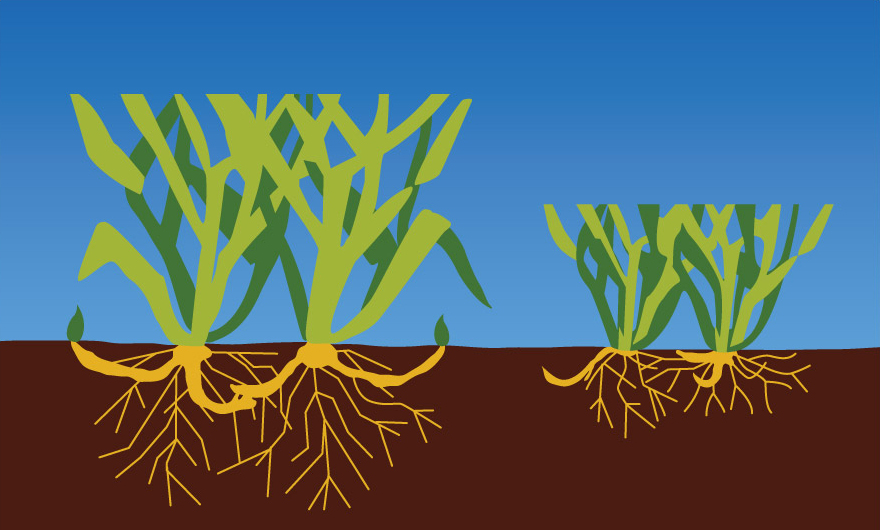
6.1.1 Height of Cut
Height of cut is important for a healthy playing surface. Setting a desired HOC is a function of the species/cultivar being managed and the intended use of the site. While taller grown turf is more likely to withstand pests and stresses, a well-groomed turf stand is preferred by many golfers for playability and aesthetic appeal.
Various heights of cut are used on different locations on a golf course. The tables shown below shows recommended HOC for turf species (Table 9 and Table 10). These HOC ranges maximize turf density, assuming water, nutrient, and cultivation needs are being met. Following a rule of thumb that no more than one-third of the plant should be removed at one time avoids scalping, which reduces turf density and can result in a dramatic reduction in root growth.
Table 9. Mowing HOC recommendations by species and location
| Turf Species | Greens (Healthy Maintenance) |
Greens (Tournament Play) | Tees, Collars, Approaches | Fairways |
|---|---|---|---|---|
| (in inches) | ||||
| Creeping bentgrass | 0.125 – 0.180 | 0.090 – 0.135 | 0.250 – 0.500 | 0.350 – 0.625 |
| Hybrid bermudagrass | 0.125 – 0.180 | 0.100 – 0.140 | 0.375 – 0.500 | 0.375 – 0.625 |
| Common bermudagrass | N/A | N/A | 0.500 – 0.625 | 0.500 – 0.750 |
| Zoysiagrass | N/A | N/A | 0.400 – 0.625 | 0.500 – 0.750 |
| Perennial ryegrass | N/A | N/A | 0.375 – 0.500 | 0.375 – 0.625 |
| Kentucky bluegrass | N/A | N/A | 0.500 – 0.750 | 0.625 – 1.00 |
Table 10. Recommended mowing heights for roughs
| Kentucky bluegrass | P. ryegrass | Tall fescue | Fine fescues | Bermudagrass |
|---|---|---|---|---|
| (in inches) | ||||
| 1.0 – 6.0 | 1.0 – 6.0 | 2.0 – 6.0 | 2.5 – 6.0 | 0.75 – 2.5 |
| For intermediate, primary and secondary roughs. Intermediate rough cuts are defined as a narrow (<10′) step-up cut immediately adjacent to the fairway. HOC for intermediate roughs are usually in the lower part of the specified ranges, typically 1.0–1.75″. | ||||
6.1.2 Seasons
Mowing height can be varied seasonally to improve responses such as spring greenup, summer stress tolerance, and cold hardening. In spring through mid-summer, longer days result in a more prostrate growth habit for warm-season grasses. During this time, bermudagrasses and zoysiagrasses can be mowed closer to enhance density without negatively affecting overall plant health. Close mowing in early spring can remove dead tissue, open the canopy to greater solar radiation, and promote faster spring greenup. For example, if the intended maintenance HOC for a bermudagrass fairway is 0.5”, begin spring mowing at 0.35”, returning to 0.5” as 80–100% spring greenup occurs.
The shorter days of late summer to autumn promote a slightly more upright growth habit for warm-season grasses. Raising HOC by 30% during this time reduces scalping potential while allowing more light interception by lower leaves. Overall, the result should be plants with greater carbohydrate storage for improved winter hardiness and canopies with greater biomass to protect crowns against winter traffic.
A similar approach could be taken with a tall fescue rough, but the first cleanup mowing should occur before active shoot growth resumes to avoid deleterious effects on spring root growth. For example, if the intended maintenance HOC for a tall fescue rough in spring is 2.75”, the first mowing should be at 1.75”, or about 40% below the intended maintenance height. This removes the upper brown leaf tissue and exposes the newer green growth to incoming radiation, enhancing soil warming, and speeding greenup. As the spring shoot growth flush begins, HOC should be returned to 2.75”. As the spring flush of shoot growth subsides and the heat of summer is looming, consider raising the height to 3” to better insulate the crown from high temperature stress, reduce weed competition, and increase late spring rooting potential for improved summer drought avoidance. With cooler temperatures of October, HOC can be lowered to 2.5” to encourage lateral growth and more efficiently mulch tree leaves into the rough. A similar seasonal approach to mowing heights for creeping bentgrass and Poa annua putting greens is recommended.
6.1.3 Frequency
Leaf growth in response to factors such as nutrient availability, environmental conditions, and plant growth regulator (PGR) use dictates mowing frequency. Maximum mowing frequency is required in the spring for cool-season grasses and in the summer for warm-season grasses.
For most turfgrasses, shoots have priority over roots for carbohydrate allocation for maintaining enough leaf area for photosynthetic energy production. Repeated removal of > 40% leaf area initially stops energy from being stored in the roots and eventually stops root growth, reducing overall root viability. Coupled with summer stress, excessive mowing often results in shoot thinning, weed invasion, and sometimes, death. If rainfall results in turf of excessive height between clips, the height of cut should be lowered in small (25–40%) increments until the desired HOC is reached. Also, the lower a turf is mowed, the more frequent the need to be cut so as to protect healthy growth while not breaking the one-third rule, which is a rule based partly on Virginia Tech research in the 1950s which states the following: Do not remove more than 30–40% of the leaf blade with any mowing.
6.1.4 Mowing Patterns and Direction
Mowing patterns influence both the aesthetic and functional characteristics of a turf surface. While patterns should be varied regularly throughout the course, the direction of cut should be changed on putting greens every time it is mowed, including changing the direction of clean up and skipping some clean-up mows. Varying mowing patterns also provides aesthetic value.
Mowing in alternating lines to create various aesthetically pleasing striping effects is most easily accomplished with cool-season rather than warm-season grasses because cool-season grass blades lay over easier and reflect light more strongly due to their waxier cuticles. Dark-colored stripes result when the rollers on the back of the mower blades have laid the turf toward the viewer’s eye; light colored stripes result when the turf is laid down away from the viewer’s eye.
Warm-season grasses such as bermudagrasses and zoysiagrasses must be repeatedly reel-mowed in the same direction to “burn-in” or train the stiffer blades to lay in a certain direction for a pronounced striping effect. This mowing approach must be used cautiously because compaction, rutting, excessive wear from turning at the same location, and formation of grain that disrupts proper ball roll can occur. Varying the striping pattern on putting greens prevents grain, encourages more upright growth, and varies wear patterns. A rotating clock pattern is recommended so that mowing direction is changed daily. Cleanup laps should be routinely reversed or skipped two to three times per week to lessen wear damage.
6.1.5 Clipping Management
Turfgrass clippings are a source of nutrients, containing 2% to 4% nitrogen on a dry-weight basis, as well as significant amounts of phosphorus and potassium. These nutrients can be sources of pollution, and therefore should be handled properly to avoid contaminating water resources. Clippings should be returned to the site during mowing unless the presence of grass clippings will have a detrimental impact on play (e.g. on greens) or when the volume of clippings is so large that it could smother the underlying grass. When possible, collecting and measuring clipping yield can assist in determining growth rates, the need for fertilization, and scheduling PGR applications. Collected clippings should be disposed of properly to prevent undesirable odors near play areas and to prevent a fire hazard due to the heat generated by composting that can occur when clippings accumulate. Consider composting clippings or dispersing them evenly in natural areas where they can decompose naturally without accumulating in piles, though care should be taken to ensure that clippings are free from pesticides.
6.1.6 Mowing Equipment
Different mowing equipment is typically used on different locations of a golf course. For example, reel mowers are ideally suited for maintaining turfgrass stands that require HOC below 1.5” and provide the best quality cut when compared with other types of mowers. Rotary mowers, when sharp and properly adjusted, deliver acceptable cutting quality for turf cut above 1” in height. Flail mowers are most often used to maintain infrequently mowed areas. Maintaining blades by sharpening and adjusting them regularly provides the best quality cut. Dull blades shred leaf tissue, increase water loss, and increase potential for disease development.
6.2 Aeration
Cultivation practices – aeration practices and surface cultivation practices – disturb the soil or thatch through the use of various implements to achieve important agronomic goals that include relief of soil compaction, thatch/organic matter reduction, and improved water and air exchange. Aeration practices consist of core aeration, deep drilling, solid tining, and high-pressure water injection. Light and frequent sand topdressing applications are also beneficial for smoothing the surface, diluting organic matter, and improving playability. Aeration frequency depends upon traffic intensity, thatch/organic matter buildup, black layer and level of soil compaction. Even though aeration is very beneficial, it disturbs the playing surface and takes some time to heal. Table 11 shows advantages and disadvantages of multiple aeration practices.
Table 11. Aeration practices
| Method | Compaction relief | Surface disruption | Water/air movement | Disruption of play |
|---|---|---|---|---|
| Hollow-tine aeration | High | Medium | High | Medium to High |
| Solid-tine aeration | Low | Low | Low to Medium | Low to Medium |
| Deep-tine aeration | Medium | Medium | High | Low to Medium |
| Deep drilling | Medium | Medium | High | High |
| Sand injection | Medium | Low | High | Low |
| High-pressure water injection | None | Low | Medium | Low |
| Air injection | Low-Medium | Low | Medium-High | Low |
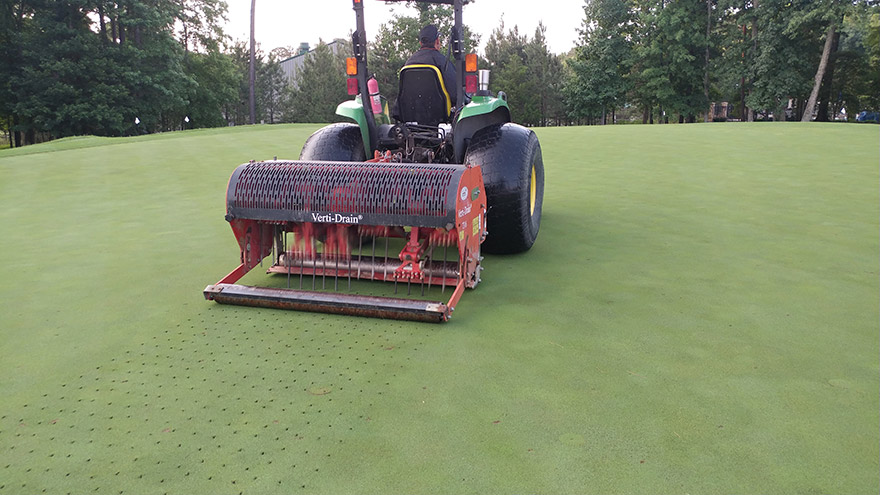
6.2.1 Hollow-tine Aeration
Hollow-tine (or core) aeration is effective at relieving soil compaction, improving internal soil drainage, and increasing oxygen in the soil. Aeration involves physically removing cores, varying in depth, diameter, and distance apart. Table 11 shows different core sizes used for aeration.
The USGA recommends organic matter dilution (OMD) programs as follows: core aerating to achieve annual surface removal of 15-20% with enough topdressing to fill all holes plus extra sand (50-200 lbs/1,000 ft2 every two to four weeks) for putting green conditioning between major cultivation events. Virginia Tech researchers implemented various iterations of the OMD program for three years on mature sand-based Penn-A4 greens at a course near Richmond and confirmed a minimum of 15% removal was required to meet this BMP (Ervin and Nichols 2011). Achieving this BMP should also result in the maintenance of 10-20% aeration porosity needed for the healthy root growth and surface water infiltration required to prevent summer bentgrass decline.
Table 12. Core size options for aeration
| Tine Size (in.) | Spacing (in.) | Holes/ft2 | Surface Area of One Tine (in.) |
Percent Surface Area Affected (Outside tine) |
|---|---|---|---|---|
| 1/4 | 1.252 | 100 | 0.049 | 3.4% |
| 1/4 | 2.52 | 25 | 0.049 | 0.9% |
| 1/2 | 1.252 | 100 | 0.196 | 13.6% |
| 1/2 | 2.52 | 25 | 0.196 | 3.4% |
| 5/8 | 2.52 | 25 | 0.307 | 5.3% |
6.2.2 Deep-tine Aeration
Deep-tine aeration loosens soils and creates aeration channels to a depth well below that of conventional core aerification. It is also used to improve air, water and nutrient movement through layered, poorly drained soils. Following deep-tine aeration, relatively large amounts of topdressing soil or organic matter can be added to the turfgrass root zone.
Either hollow tines or solid tines may be used in deep-tine aeration; solid tines are often preferred when cultivating heavily compacted clay soils or gravelly soils for the first time. Cultivating with a conventional aerifier before using a deep-tine aerifier with solid tines may prove very beneficial as the aeration channels created by the conventional core aerifier receive some of the soil displaced by deep-tine, solid-tine aerification and lessens the disruption of the turf surface with fewer turfgrass plants lifted from the soil.
6.2.3 Deep Drilling
Deep-drill aeration creates deep holes (8-10”) in the soil surface profile through use of drill bits. Soil is brought to the surface and distributed into the canopy. Holes can be backfilled with new root zone materials if a drill-and-fill machine is used. These machines allow replacement of heavier soils with sand or other materials in an effort to improve water infiltration into the soil profile.
The process is slow and the equipment expensive, requiring most golf courses to hire a contractor. Moreover, going over the green once (with a 6” spacing between holes) renovates only approximately 5% of the root zone. Therefore, the process must be repeated multiple times for best effect.
6.2.4 Root Zone Injection
Sand Injection
Sand injection, which injects small columns of sand into the root zone without removing cores, has been used recently as a supplement to traditional core aeration. The injection depth should be adjusted so the majority of sand is injected where it is needed most, often in the upper root zone.
High-Pressure Water Injection
A more effective and slightly longer lasting summer approach for promoting water penetration and air exchange is high-pressure water injection. Fine streams of high-velocity water are injected, creating channels that are 1/8-1/4” diameter to a depth of 4-8”. These small diameter holes do not disrupt play and have been shown to improve water infiltration for three to four weeks. Thus, high-pressure water injection, conducted every three to four weeks in the summer, serves as an excellent supplement to hollow-tine aerification to prevent summer putting green decline.
Air Injection
Air injection, which is a new technology that laterally injects pressurized air beneath the surface of the soil, is used to relieve compaction, and increase porosity. A benefit of this technology is that the turfgrass surface has little to no disturbance.
6.3 Surface Cultivation
The goals of surface cultivation are to manage organic matter accumulation above the soil, reduce the formation of leaf grain, improve infiltration, and improve surface consistency (Table 13). These methods are generally less disruptive than traditional aeration practices and can quickly impact a large percentage of the turfgrass canopy. They usually have low to no impact on soil compaction.
Table 13. Surface cultivation practices
| Method | Compaction relief | Surface disruption | Water/air movement | Disruption of play |
|---|---|---|---|---|
| Vertical mowing | Low | Medium to High | Medium | Low to High |
| Spiking/slicing | None | Low | Low | None |
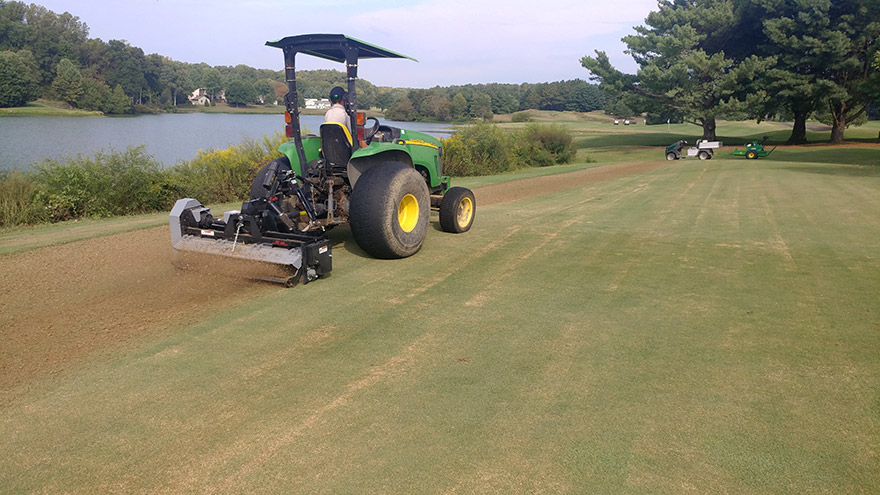
6.3.1 Vertical Mowing
Vertical mowing can be incorporated into a cultural management program to achieve a number of goals. The grain of a putting green can be reduced by setting a verticutter to a depth that just nicks the surface of the turf. Frequent, light vertical mowing minimizes grain formation. Deeper penetration of knives stimulates new growth by cutting through stolons and rhizomes while removing accumulated thatch. A more aggressive, deep vertical mowing can reach a depth of 0.5-1”, removing a greater amount of thatch compared with other cultivation practices. Even though this is beneficial, deeper vertical mowing should not be used when the grass is growing slowly because aggressive growth is needed to fill in disturbed areas.
6.4 Topdressing
The primary goal for any sand topdressing program is to dilute organic matter and produce smooth, firm putting surfaces while minimizing golfer and mower impact. As part of a program, sand topdressing improves the soil structure and can relieve surface compaction, improve drainage, increase water and air infiltration, and protect turf crowns. The important considerations for a sand topdressing program include sand type, application rate, and application frequency.
6.4.1 Sand Type
When purchasing sand for topdressing, it is important to consider the source, cost, texture, and overall quality of the sand. For example, angular sand performs better than spherical shaped sand for topdressing. Two or more sand materials can be used for a topdressing program; a coarse type for aeration and topdressing when playability is less important (e.g. as part of winterization preparation), and another less-coarse sand that can be used for routine topdressing to minimize disruptions to play.
Similarly, topdressing with sand with greater than 25 percent fine material (0.15-0.25 mm) could potentially lead to problems associated with layering, such as increased moisture at the surface of the greens. Collecting soil cores and analyzing for physical characteristics every few years can be used to monitor putting green performance.
6.4.2 Application Rate and Frequency
Two application rates must be considered in a topdressing program: the rate for each topdressing event and the annual rate achieved from the sum of all topdressing events. An annual rate of 25-35 cubic feet of sand per 1,000 ft2 is a typical range for dilution of organic matter. Factors to consider in determining optimal topdressing rates include the length of the growing season, quality of the growing environment, turfgrass species and cultivar, nitrogen fertilization program, and traffic intensity.
Individual application rates must be considered in conjunction with the application frequency, as increasing application frequency decreases the topdressing rate. Light and frequent topdressing (e.g. on the order of every one to three weeks) is usually recommended, which reduces the disruption to playing surfaces and is easier to apply and incorporate. See Table 14 for application rates for light and frequent topdressing. When necessary, an accelerated program can be followed to quickly improve root zone conditions and playability.
For more information on topdressing recommendations, see the USGA article “Light and Frequent Topdressing Programs.”
Table 14. Light and frequent topdressing rates
| Quantity (ft3/1,000 ft2) | Quantity (lbs/1,000 ft2) | Quantity (tons/acre) | Depth of Application (inches) |
|---|---|---|---|
| 0.50 | 50 | 1.1 | 0.006 |
| 0.75 | 75 | 1.7 | 0.009 |
| 1 | 100 | 2.2 | 0.012 |
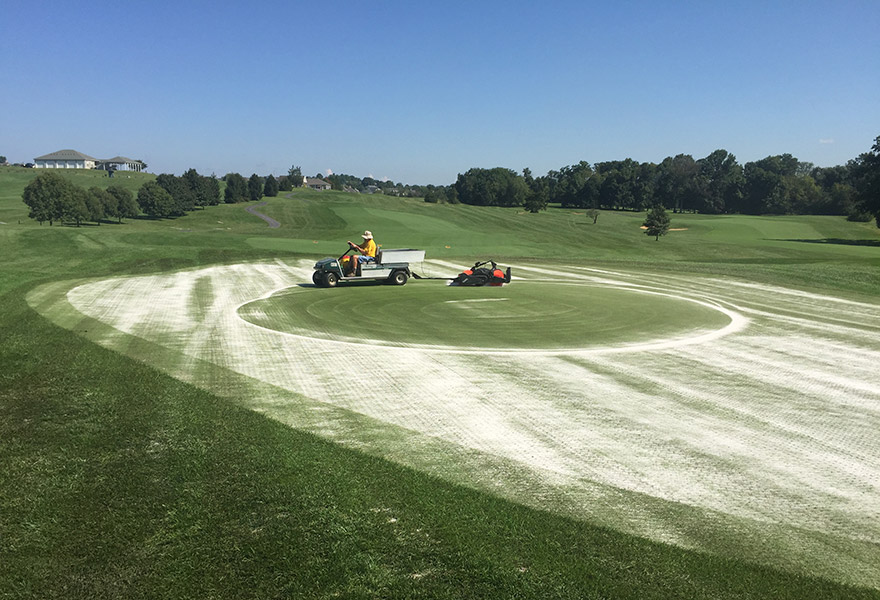
6.4.3 Topdressing with Compost
While the most frequent material for topdressing golf turf is a specified sand, topdressing with compost has a number of advantages. Virginia has a wide variety of quality compost materials available. While it is highly unlikely a compost source would be used on putting greens because the focus is on keeping water moving into and through these soils, regular compost applications on heavier textured, naturally occurring soils such as fairways and roughs can enhance soil structure and improve overall soil health. Research at Penn State reported that as little as 0.25 inch depth of topdressed compost applied one to two times per year vastly improves soil health within a few years and improves soil properties more quickly when linked to core aeration events. Improving the soil physical and chemical properties with compost can ultimately reduce overall irrigation, fertility and pesticide inputs.
6.5 Overseeding
Overseeding is the process of seeding a cool-season grass, primarily perennial ryegrass, into a dormant bermudagrass canopy to provide a green late fall to early spring playing surface. Overseeding is not considered a BMP as it may negatively affect the underlying bermudagrass.
Additional late fall to early spring fertilizer applications are often required to ensure proper growth and development of the overseeded perennial ryegrass, which increases the chance of N and P runoff during the winter. The main reasons for overseeding bermudagrass are almost always aesthetics and the potential for increased winter golf revenue. This common Virginia scenario may have a number of disadvantages, including:
- Poor aesthetics.
- Poor playability (i.e. ground-under-repair).
- Added costs for re-establishment (fertilizer, aerification, seeding, sprigging, sodding, irrigation, labor).
- Greater weed pressure.
- Open soil susceptible to loss of sediment-bound N and P.
- Resource-depleted bermudagrass stand more susceptible to winter-kill.
Thinning of the bermudagrass stand occurs due to competition. In the spring, perennial ryegrass competes very aggressively with the greening-up bermudagrass until air temperatures consistently reach the high 80 degrees F, which may not occur until late June in many parts of Virginia. Such competition delays total bermudagrass fill-in and, if a heat wave causes the overseeding to quickly die, results in a thin, soil-exposed stand of bermudagrass. For courses that still choose to overseed, gradual transitions from bermudagrass to perennial ryegrass in the fall and back to bermudagrass in late spring are necessary to maintain consistent turf playability.
For superintendents who do chose to seed, a number of considerations apply. For example, seeding too early can result in excessive bermudagrass competition and disease pressure (gray leaf spot and Pythium damping-off) that thins the perennial ryegrass seedlings to the point where re-seeding is necessary. Seeding too late may result in reduced seedling vigor and thin perennial ryegrass cover through the winter. Consistent night temperatures of around 50 degrees F are one of the most dependable indicators for overseeding timing. In addition, overseeding should be completed two to three weeks prior to the first killing frost. These timings minimize bermudagrass competition and still provide sufficient soil and air temperatures for perennial ryegrass germination and development.
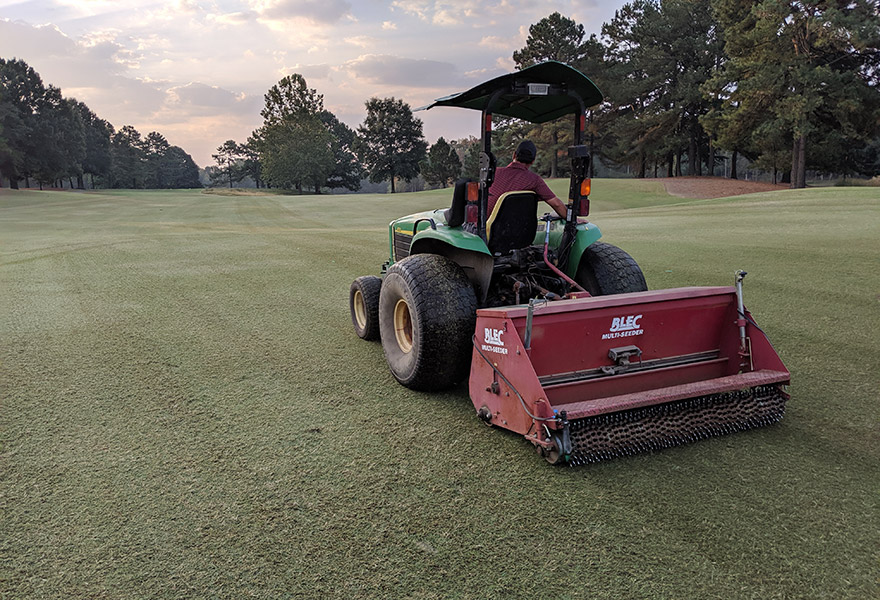
6.6 Rolling
Rolling can help smooth the putting surface and maintain speeds at higher HOC. Even with a raised HOC, rolling can increase ball roll by 10 percent. Light-weight rollers typically have little negative impact on soil compaction unless the practice is overutilized or is used on high silt and clay soils when saturated with water. Rolling can also be used to remove dew from the playing surface, which reduces the possibility of dollar spot.
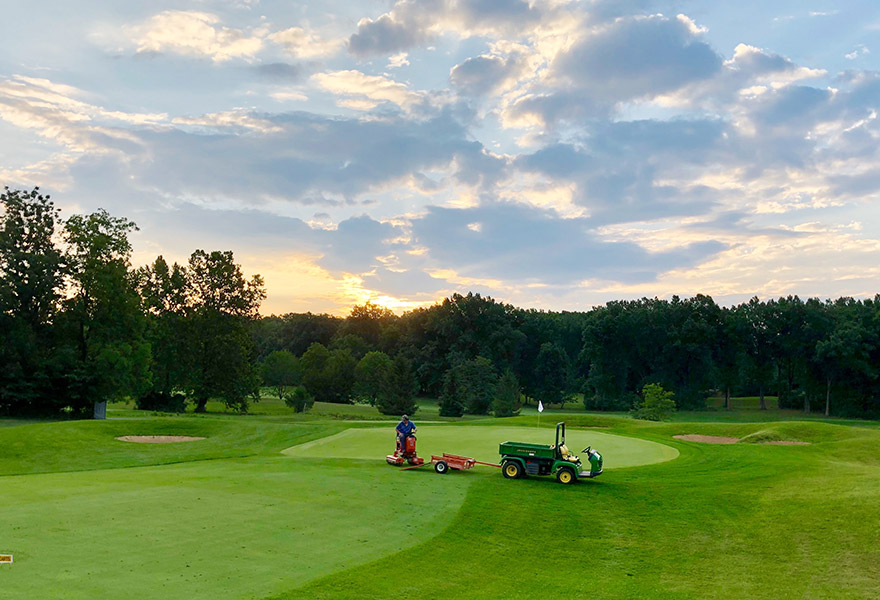
6.7 Wetting Agents
Wetting agents have the general purpose of reducing the surface tension of water and increasing the distribution or penetration of water or solution on plants or in soils. They can be used for a number of reasons, such as treating dry spots; preventing dry spot development; to move water into and through the soil; improve irrigation efficiency; or as a spray adjuvant when applying pesticides or PGRs. Wetting agents are especially helpful when applied to sandy soils that can become hydrophobic (water repellent). Turf grown on sand-based root zones can develop severe localized dry spots (LDS) especially when the stand is irrigated deep and infrequently. Surfactants help promote water infiltration into these hydrophobic areas which prevents and alleviates LDS.
Research shows preventive applications can increase soil water uniformity and sustain high visual turfgrass quality at very low levels of irrigation (30% pET). Preventive applications of wetting agents can also increase irrigation precision, which reduces water use while maximizing playing conditions. In addition, their use can reduce electrical usage and wear and tear on pumps associated with irrigation systems. Late fall applications may reduce water repellency in soils well into the spring after being applied in the late fall, reducing the potential for LDS in the spring. In Virginia, the benefits of a late fall application will typically last until April.
For more information on wetting agents, see the USGA publication Understanding Wetting Agents.
In addition to a variety of chemistries available for wetting agent products, natural options to improve water movement in the soil include yucca extracts and gypsum (calcium sulfate).
6.8 Plant Growth Regulators
There are two broad categories of PGRs used in fine turf: Type I (products that disrupt cell division, suppressing both vegetative growth and seedhead formation) and Type II (products that reduce cell elongation and have little to no effect on seedhead formation). PGR selection for golf turf changes throughout the growing season depending on the turf to be treated (greens, tees, fairways, or roughs), the turfgrass itself, and the desired response. Plant growth regulators are frequently used to reduce clipping yield, improve stress tolerance, and improve turf quality and performance. Additional benefits of using PGRs is a reduction in the use of other inputs (e.g. labor, fuel, fertilizers, pesticides).
PGRs require frequent reapplication during the growing season to maintain consistent growth suppression, but excessive PGR use can result in a number of undesirable side effects. These side effects might include mild discoloration, stressed turf, and segregation of grasses like creeping bentgrass and annual bluegrass. These effects can be confused with disease and can intensify damage from pests and traffic.
The best approach to planning PGR applications is to use growing degree day (GDD) thresholds instead of a calendar-based schedule. Free tools are available online for assistance in using GDD information to schedule PGR applications. For more information on using GDD to schedule PGR applications, see the Golfdom article “Looking at GDD: The Perils of PGR Over-Regulation.”
6.9 Cultural Practices Best Management Practices
Mowing
- Follow the recommended HOC for different turf species.
- Raise HOC by at least 30% in heavily shaded areas to improve turf health.
- Routinely use plant growth regulators, if needed, to improve overall turf health in shaded environments.
- Increase HOC in times of stress such as heat, drought, or prolonged cloudy weather to increase photosynthetic capacity and rooting depth of plants.
- If turf becomes too tall, it should not be mowed to the desired height all at once. Tall grass should be mowed frequently and HOC gradually decreased until the desired HOC is achieved.
- Mowing frequency should increase during periods of rapid growth and decrease during dry, stressful periods.
- Decrease mowing frequency and increase HOC when the turf is stressed.
- Change mowing patterns on all locations of the golf course.
- Change direction of mow on greens every time the turf is mowed.
- Rarely use inefficient mowing patterns (e.g. 9-3) on areas other than putting greens to save time, fuel, and labor.
- Return clippings to the canopy whenever possible.
- Use compressed air to blow off clippings from mowing equipment over grassed areas and before washing equipment.
- Collect pesticide-free clippings and compost or distribute them in natural areas, away from surface waters.
- Use proper mowing equipment.
- Regularly sharpen and adjust blades.
Aeration
- When thatch levels are excessive, core aeration programs should be designed to remove 15% to 20% of the surface area and to minimize grain formation.
- High traffic areas may require a minimum of two to four core aerations annually.
- Core aeration should be conducted only when grasses are actively growing in the spring and fall to aid in quick recovery of surface density.
- Aeration events should be as deep as practical to prevent development of compacted layers in the soil profile as a result of cultivation.
- Consider timing of core aeration to avoid the period of Poa annua (annual bluegrass) seed head formation.
- Backfill holes with new root zone materials if a drill-and-fill machine is used.
- High-pressure water injection can be applied once every three to four weeks throughout the summer.
Surface Cultivation
- Initiate vertical mowing when thatch level reaches 0.25-0.5” in depth. Shallow vertical mowing should be done at least monthly on putting greens to prevent excessive thatch accumulation.
- Vertical mowing depth for thatch removal should reach the bottom of the thatch layer and extend into the surface of the soil beneath the thatch.
- Aggressive or deep vertical mowing should not be used when the turf is growing slowly.
- Frequent shallow vertical mowing on putting greens prevents excessive thatch buildup and grain formation.
Topdressing
- Assess root zone physical characteristics regularly by analyzing core samples to determine topdressing needs and evaluate the topdressing program.
- Know the sand source and ensure that sand is weed-free, uniform, and of appropriate quality.
- Use silica sand if possible because of its tolerance to weathering.
- Determine a rate and frequency for each topdressing event based on an annual topdressing goal, adjusting if needed to match growth and organic matter accumulation.
- Use light and frequent topdressing applications with or without aeration, according to Table 14.
- Aeration backfill should closely match the physical characteristics of the sand used at construction, but routine topdressing sand can be somewhat less coarse to ease incorporation and reduce wear on mowers.
- Light sand topdressings can be effectively brushed, rolled, or irrigated into the turf canopy.
- Double-mowing and increasing the frequency of clip should be avoided following topdressing to reduce sand harvesting and wear on mowers.
Rolling
- Roll putting surfaces following mowing to increase putting speeds and allow for improved ball roll without lowering HOC.
- Avoid rolling on saturated soils to avoid compaction.
- Use lightweight rollers to minimize potential compaction.
Overseeding
- Time overseeding to minimize bermudagrass competition, ensuring that soil and air temperatures are sufficient for perennial ryegrass germination and development.
- Open up and remove much of the slow-growing bermudagrass canopy by lowering the HOC for a slight scalping to improve seed to soil contact and improve establishment.
- For best uniformity and to avoid skips, spread seed in at least two directions.
- Seed fairways and tees at 250-800 pounds of pure live seed per 1,000 ft2; the specific rate chosen depends on the experience and expectations of the golf course superintendent.
- Consider sand topdressing (5-10 tons/acre) and dragging following seeding for greater establishment.
- Apply a starter fertilizer at seeding to supply 0.5 lb N per 1,000 ft2 to provide adequate N and P for seedling development.
- In dry conditions, irrigating lightly 3-4 times daily keeps the surface moist but not puddled.
- When seedlings reach about 1”, approximately 14-28 days after seeding, mow at a 0.75” HOC to allow seedlings to root.
- Fertilize after the first or second mowing and continue until cold weather at a rate of 0.25–0.5 lbs N per 1,000 ft2 every three to four weeks with a soluble N source.
- Apply P and K application based on need established solely by soil test results.
- Control perennial ryegrass as summer approaches. In the hottest areas of Virginia, encourage it to die out by scalping, increasing application rates of soluble N, aggressive vertical mowing, and reducing irrigation.
Wetting Agents
- Preventive applications of wetting agents should be made to high risk (sandy) soils.
- Frequent preventive applications prevent development of localized dry spot and increases soil water uniformity.
- Water-in wetting agents sufficiently.
- Apply wetting agents in the late fall to reduce water repellency in soils and reduce the potential for localized dry spot.
PGRs
- Use GDD to plan PGR use.
- Consider the selection and timing of PGR applications, which is critical to achieve desired turfgrass responses.





